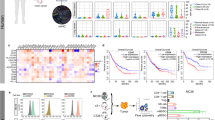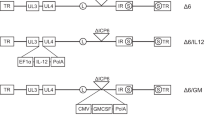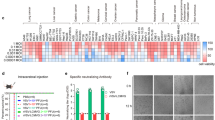Abstract
To increase the antitumor effects of cytosine deaminase (AdCD) gene therapy and induce more potent antitumor immunity, Th1 cytokine interleukin-18 encoded adenovirus (AdIL18) was combined with adenovirus encoding CD (AdCD) for the therapy of established murine B16 melanoma. Combination therapy of the tumor-bearing mice with AdIL18 and AdCD/5FC inhibited the growth of the subcutaneous B16 tumors more significantly, compared with AdIL18 or AdCD/5FC alone. In vivo depletion analysis with anti-CD4, anti-CD8 or anti-NK 1.1 McAb illustrated that both CD8+ T cells and CD4+ T cells played key roles in the augmented antitumor response of the combined therapy. Peptide/MHC tetramer represents a powerful and general tool for rapid, highly sensitive, and direct analysis of antigen-specific T cells. In this study, we prepared H-2Kb/TRP- 2180–188 tetramer, which was demonstrated to bind H-2Kb-restricted, B16 melanoma-specific CD8+T cells. B16 specific H-2Kb/TRP2180–188 tetramer was used to stain the tumor-specific CD8+ T cells and the results showed that CD8+ tetramer+ T cells were about 3–5% of the splenic CD8+ T cells derived from tumor-bearing mice after combined therapy. The CTL cytotoxicity was markedly induced in mice after combined therapy, suggesting efficient induction of tumor-specific CD8+ T cells after combined gene therapy with AdCD/5FC/AdIL18. IL-18 gene transfer could significantly augment the cytotoxicity of NK cells and macrophages, and increase the production of interleukin-2 and interferon-γ, as compared with treatments with AdCD/5FC, AdlacZ/5FC or PBS. These data suggested that in vivo IL-18 gene transfer could augment the antitumor effects of CD suicide gene therapy through efficient induction of antitumor immunity.
This is a preview of subscription content, access via your institution
Access options
Subscribe to this journal
Receive 12 print issues and online access
$259.00 per year
only $21.58 per issue
Buy this article
- Purchase on Springer Link
- Instant access to full article PDF
Prices may be subject to local taxes which are calculated during checkout






Similar content being viewed by others
References
Deonarain MP, Spooner RA, Epenetos AA . Genetic delivery of enzymes for cancer therapy Gene Therapy 1995 2: 235–244
Mullen CA, Petropoulos D, Lowe RM . Treatment of microscopic pulmonary metastases with recombinant autologous tumor vaccine expressing interleukin 6 and Escherichia coli cytosine deaminase suicide genes Cancer Res 1996 56: 1361–1366
Freeman SM, Ramesh R, Marrogi AJ . Immune system in suicide-gene therapy Lancet 1997 349: 2–3
Cao X et al. Adenovirus-mediated GM-CSF gene and cytosine deaminase gene transfer followed by 5-fluorocytosine administration elicit more potent antitumor response in tumor-bearing mice Gene Therapy 1998 5: 1130–1136
Ju DW, Wang BM, Cao X . Adenovirus-mediated combined suicide gene and interleukin-2 gene therapy for the treatment of established tumor and induction of antitumor immunity J Cancer Res Clin Oncol 1998 124: 683–689
Ju DW et al. Adenovirus-mediated lymphotactin gene transfer improves therapeutic efficacy of cytosine deaminase suicide gene therapy in established murine colon carcinoma Gene Therapy 2000 7: 329–338
Altman JD et al. Phenotypic analysis of antigen-specific T lymphocytes Science 1996 274: 94–96
Murali-Krishna K et al. Counting antigen-specific CD8 T cells: a re-evaluation of bystander activation during viral infection Immunity 1998 8: 177–187
Gallimore A et al. Induction and exhaustion of lymphocytic choriomeningitis virus-specific cytotoxic T lymphocytes visualized using soluble tetrameric major histocompatibility complex class I-peptide complexes J Exp Med 1998 187: 1383–1393
Gutgemann I et al. Induction of rapid T cell activation and tolerance by systemic presentation of an orally administered antigen Immunity 1998 8: 667–673
Ogg GS, McMichael AJ . HLA-peptide tetrameric complexes Curr Opin Immunol 1998 10: 393–396
Bieganowska K et al. Direct analysis of viral-specific CD8+ T cells with soluble HLA-A2/Tax11–19 tetramer complexes in patients with human T cell lymphotropic virus-associated myelopathy J Immunol 1999 162: 1765–1771
Yee C et al. Isolation of high avidity melanoma-reactive CTL from heterogeneous populations using peptide-MHC tetramers J Immunol 1999 162: 2227–2234
Savage PA, Boniface JJ, Davis MM . A kinetic basis for T cell receptor repertoire selection during an immune response Immunity 1999 10: 485–492
Okamoto I et al. Development of CD8+ effector T cells is differentially regulated by IL-18 and IL-12 J Immunol 1999 162: 3202–3211
Garcia VE et al. IL-18 promotes type 1 cytokine production from NK cells and T cells in human intracellular infection J Immunol 1999 162: 6114–6121
Bloom MB et al. Identification of tyrosinase-related protein 2 as a tumor rejection antigen for the B16 melanoma J Exp Med 1997 185: 453–459
Ogg GS et al. Quantitation of HIV-1-specific cytotoxic T lymphocytes and plasma load of viral RNA Science 1998 279: 2103–2106
Pareja E, Tobes R, Martin J, Nieto A . The tetramer model: a new view of class II MHC molecules in antigenic presentation to T cells Tiss Antigens 1997 50: 421–428
Rogulski KR, Kim JH, Kim SH, Freytag SO . Glioma cells transduced with an Escherichia coli CD/HSV 1 tk fusion gene exhibit enhanced metabolic suicide and radiosensitivity Hum Gene Ther 1997 8: 73–85
Uckert W et al. Double suicide gene (cytosine deaminase and herpes simplex virus thymidine kinase) but not single gene transfer allows reliable elimination of tumor cells in vivo Hum Gene Ther 1998 9: 855–865
Chen SH et al. Combination suicide and cytokine gene therapy for hepatic metastases of colon carcinoma sustained antitumor immunity prolongs animal survival Cancer Res 1996 56: 3758–3762
Chen SH et al. Combination gene therapy for liver metastasis of colon carcinoma in vivo Proc Natl Acad Sci USA 1995 92: 2577–2581
Benedetti S et al. Limited efficacy of the HSV-TK/GCV system for gene therapy of malignant gliomas and perspectives for the combined transduction of the interleukin-4 gene Hum Gene Ther 1997 8: 1345–1353
McMichael AJ, O'Callaghan CA . A new look at T cells J Exp Med 1998 187: 1367–1371
Kuroda MJ et al. Analysis of Gag-specific cytotoxic Tlymphocytes in simian immunodeficiency virus-infected rhesusmonkeys by cell staining with a tetrameric major histocompatibility complex class I-peptide complex J Exp Med 1998 187: 1373–1381
Callan MF et al. Direct visualization of antigen-specific CD8+ T cells during the primary immune response to Epstein–Barr virus in vivo J Exp Med 1998 187: 1395–1402
Crawford F et al. Detection of antigen-specific T cells with multivalent soluble class II MHC covalent peptide complexes Immunity 1998 8: 675–682
Ju DW et al. Interleukin 18 gene-modified dendritic cell-tumor vaccine elicited potent antitumor response through induction of tumor specific CD8+ T cells and CD4+ T cells Cancer Res (submitted)
Toes RE, Ossendorp F, Offringa R, Melief CJ . CD4 T cells and their role in antitumor immune responses J Exp Med 1999 189: 753–756
Hung K et al. The central role of CD4+ T cells in the antitumor immune response J Exp Med 1998 188: 2357–2368
Bennett SR et al. Help for cytotoxic-T cell responses is mediated by CD40 signalling Nature 1998 393: 478–480
Kalams SA, Walker BD . The critical need for CD4 help in maintaining effective cytotoxic T lymphocyte responses J Exp Med 1998 188: 2199–2204
Tomura M et al. A critical role for IL-18 in the proliferation and activation of NK1.1+ CD3-cells J Immunol 1998 160: 4738–4746
Hyodo Y et al. IL-18 up-regulates perforin-mediated NK activity without increasing perforin messenger RNA expression by binding to constitutively expressed IL-18 receptor J Immunol 1999 162: 1662–1668
Takeda K et al. Defective NK cell activity and Th1 response in IL-18-deficient mice Immunity 1998 8: 383–390
Dao T et al. Interferon-gamma-inducing factor, a novel cytokine, enhances Fas ligand-mediated cytotoxicity of murine T helper 1 cells Cell Immunol 1996 173: 230–235
Schatz PJ . Use of peptide libraries to map the substrate specificity of a peptide-modifying enzyme: a 13 residue consensus peptide specifies biotinylation in Escherichia coli Biotechnology (N Y) 1993 11: 1138–1143
Shields MJ et al. The effect of human beta2-microglobulin on major histocompatibility complex I peptide loading and the engineering of a high affinity variant. Implications for peptide-based vaccines J Biol Chem 1998 273: 28010–28018
Busch DH, Pilip I, Pamer EG . Evolution of a complex T cell receptor repertoire during primary and recall bacterial infection J Exp Med 1998 188: 61–70
Kanai F et al. In vivo gene therapy for alpha fetoprotein producing hepatocellular carcinoma by adenovirus mediated transfer of cytosine deaminase gene Cancer Res 1997 57: 461–465
Porgador A, Snyder D, Gilboa E . Induction of antitumor immunity using bone marrow-generated dendritic cells J Immunol 1996 156: 2918–2926
Ju DW, Cao X, Arces B . Intratumoral injection of GM-CSF gene encoded recombinant vaccinia virus elicits potent antitumor response in a murine melanoma model Cancer Gene Ther 1997 4: 139–144
Acknowledgements
This work was supported by grants from the National Natural Science Foundation of China (39600181, 39708173) and National High Biotechnology Foundation of China (96Z032).
Author information
Authors and Affiliations
Rights and permissions
About this article
Cite this article
Ju, D., Yang, Y., Tao, Q. et al. Interleukin-18 gene transfer increases antitumor effects of suicide gene therapy through efficient induction of antitumor immunity. Gene Ther 7, 1672–1679 (2000). https://doi.org/10.1038/sj.gt.3301291
Received:
Accepted:
Published:
Issue Date:
DOI: https://doi.org/10.1038/sj.gt.3301291
Keywords
This article is cited by
-
Cytotoxic effect of co-expression of human hepatitis A virus 3C protease and bifunctional suicide protein FCU1 genes in a bicistronic vector
Molecular Biology Reports (2017)
-
Oncolytic adenovirus expressing interleukin-18 induces significant antitumor effects against melanoma in mice through inhibition of angiogenesis
Cancer Gene Therapy (2010)
-
Intratumoral delivery of IL-18 naked DNA induces T-cell activation and Th1 response in a mouse hepatic cancer model
BMC Cancer (2007)
-
Interleukins 18 and 21: Biology, mechanisms of action toxicity, and clinical activity
Current Oncology Reports (2006)
-
Antitumor immune responses mediated by adenoviral GDEPT using nitroreductase/CB1954 is enhanced by high-level coexpression of heat shock protein 70
Cancer Gene Therapy (2005)



